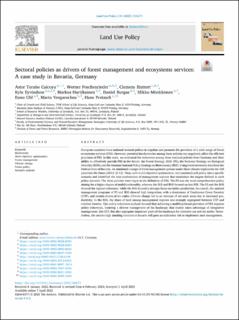| dc.description.abstract | European countries have national sectoral polices to regulate and promote the provision of a wide range of forest ecosystems services (FES). However, potential incoherencies among these policies can negatively affect the efficient provision of FES. In this work, we evaluated the coherence among three national policies from Germany and their ability to effectively provide FES in the future: the Forest Strategy 2020 (FS), the National Strategy on Biological Diversity (BDS), and the German National Policy Strategy on Bioeconomy (BES). Using forest inventory data from the Federal State of Bavaria, we simulated a range of forest management options under three climate trajectories for 100 years into the future (2012–2112). Then, with multi-objective optimization, we translated each policy into a specific scenario and identified the best combination of management regimes that maximizes the targets defined in each policy scenario. The three policies were vague in the definition of FES. The FS was the most comprehensive policy aiming for a higher degree of multifunctionality, whereas the BES and BDS focused on less FES. The FS and the BDS showed the highest coherence, while the BES showed a stronger focus on timber production. As a result, the optimal management programs of FS and BDS showed high integration, with a dominance of Continuous Cover Forestry (CCF), and certain shares of set asides. Climate change led to an increase of set aside areas due to increased productivity. In the BES, the share of land among management regimes was strongly segregated between CCF and rotation forestry. Our policy coherence analysis showed that achieving a multifunctional provision of FES requires policy coherence, fostering a diverse management of the landscape that mainly takes advantage of integrative management, like CCF, but also segregates important parts of the landscape for intensive use and set asides. Nevertheless, the current high standing volumes in Bavaria will pose an additional risk to implement such management. | en_US |

